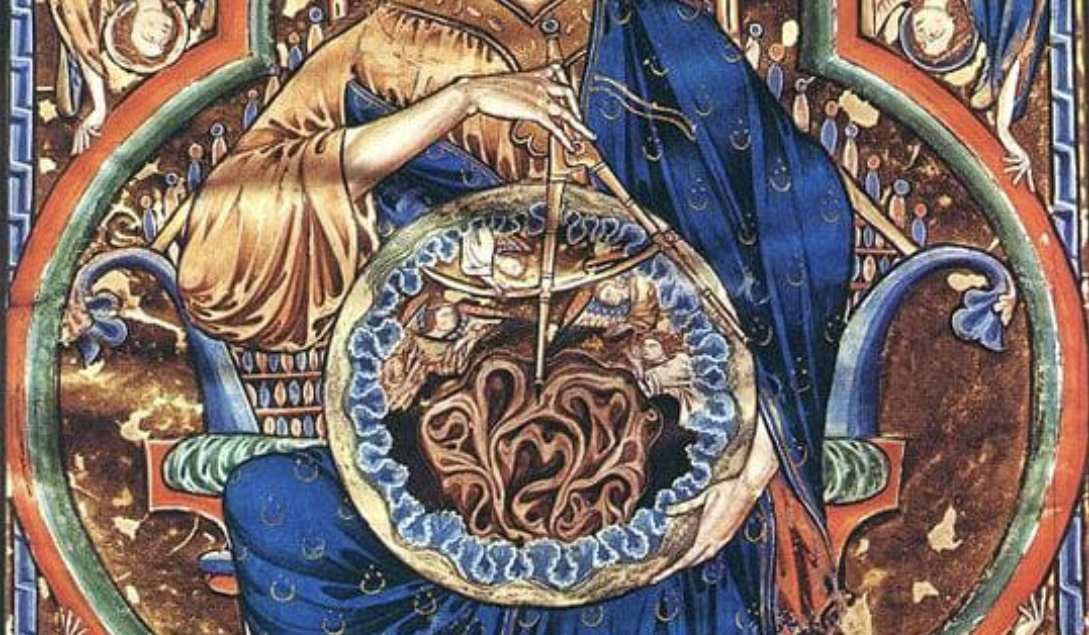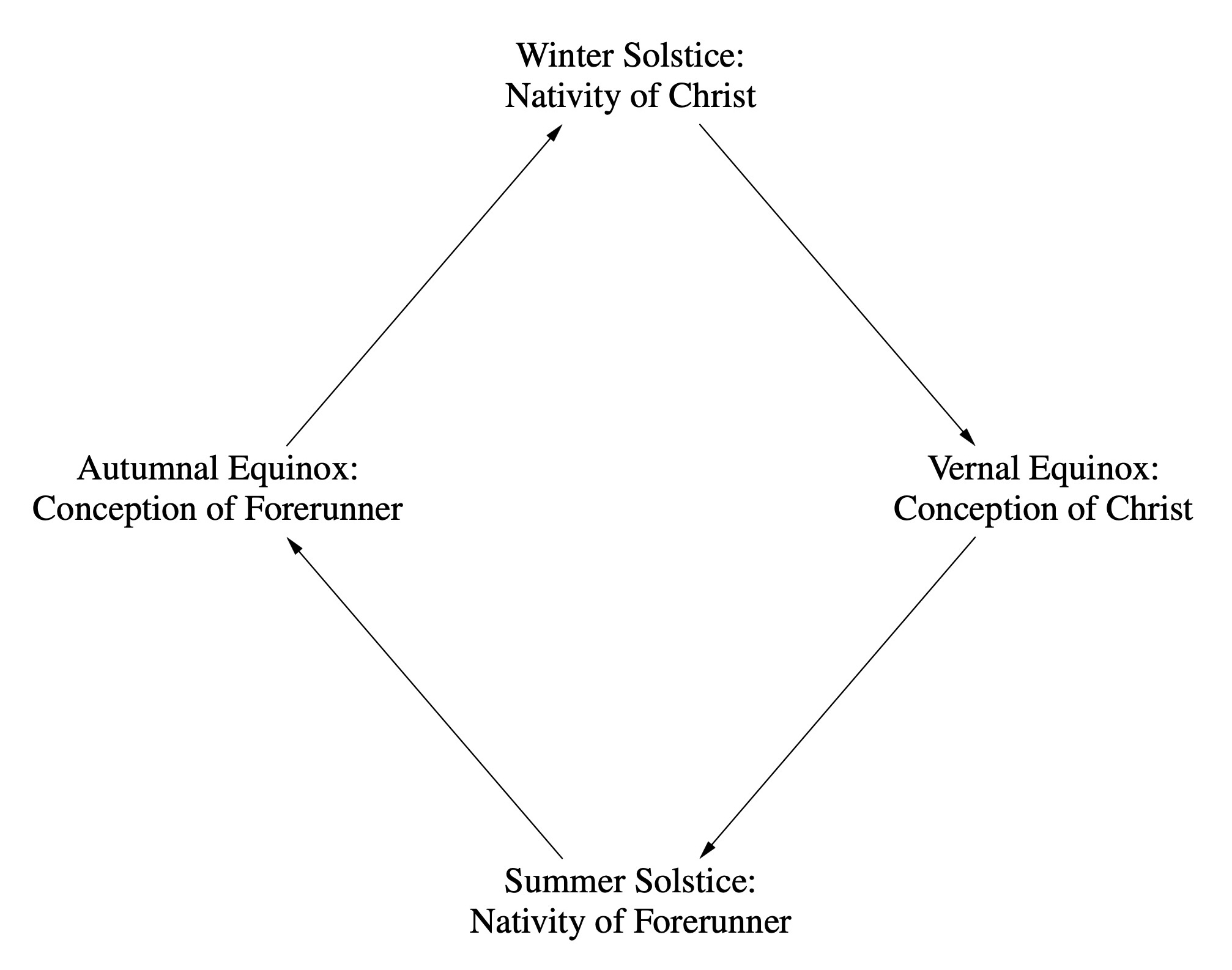
Luke 24:1-12 (Matins)
Galatians 4:22-33
Lu 1:5-25
The Holy Circle
It is He who sits above the circle of the earth,
And its inhabitants are like grasshoppers,
Who stretches out the heavens like a curtain,
And spreads them out like a tent to dwell in.
(Isa 40:22)
In the Name of the Father and of the Son and of the Holy Ghost.
Amen.
Today we celebrate the Feast of the Conception of St. John the Baptist.
But this is one-fourth of a longer feast which we celebrate every year.
He is called the Forerunner.
Not only does He announce the coming the Lord as the Christ.
But His conception and birth announce the Conception and Nativity of our God among us.
This is emphasized in the Gospel narrative as "the babe leapt in her womb"
at the approach of the unborn baby Jesus.
☦
Now, last week we went back to basics.
We said that three wise men from the East read and interpreted the living creation;
that
all things in the physical world are about God;
that God is the only reality finally;
and
that there are the two ways:
God's way of seeing (and being), which is the way of life,
and
a secondary, lesser way,
which leads finally to frailty, often to disease, and always to death.
It goes without saying that the vast majority of men and women only habituate the lesser way.
But in the midst of all this,
our calling God has placed His Heavenly Kingdom,
stetched out like a curtain,"
brilliantly present to those who see it and hear it and have their being in it.
We must be clear on this point.
Everyone born into the world is called to
the Kingdom of God.
But the Kingdom of God is only for those who see it and reverence it and
seek its governance in every aspect of their lives.

Christians live by a different calendar than the world uses.
Indeed,
in this recent era,
so antagonistic to God,
even the custom of numbering the years as B.C. and A.D.,
giving first place to the Advent of God,
has been banished.
The new method is called "C.E." and "B.C.E.",
"Common Era"
and
"Before Common Era"
(whatever that means),
which is a weak attempt to secularize time.
The attempt to marginalize the claims
of God on our lives,
indeed,
to declare that God does not exist,
Christians plainly reject.
God, by His very Nature, cannot be marginalized.
He is what everything is about
—
the center of every circle.
The secular way to
account for the movement and motions of our planet
with respect to the sun
is marked by four annual events:
the Winter Solstice (when the sun is farthest south);
the Vernal Equinox (when the sun is over the equator);
the Summer Solstice (when the sun is farthest north);
and
the Autumnal Equinox (when the sun is again over the equator),
which we perceive to be its yearly journey.
(All this is from the perspective of the Northern Hemisphere
because the people who first made these calculations did not
know there was a Southern Hemisphere.)
But we Christians regard all such distinctions to be secondary,
as things indifferent.
Like those Northern Hemisphere calculators, we believe that we shall learn
more and still more and still more in God's universe.
We draw our measurements from things holy:
the Annunciation signifying the Conception of God within the material Creation
(readying us for His Nativity nine months later)
and
the Conception of His Forerunner
(preparing us for his birth nine months later).
In our way of seeing,
their births, six months apart, mark the pivotal moments in
the history of the world.
It need hardly be said that the Annunciation
falls on what world calls the Vernal Equinox (the season of new life),
that the Lord's Nativity falls at the Winter Solstice (a light born at the moment of greatest darkness),
and
that St. John's conception falls at the Autumnal Equinox
and
his birth on the Summer Solstice.
That these holy conceptions and holy births should occur
at the four corners of the year
might appear to be a wonderful timing of biological events.
But I don't think of it that way.
But I think of it as being even more basic,
more elemental
in the ordering of our world.
That is, I believe that the very structure of everything we perceive
is patterned upon Him, the Lord God Jesus Christ.
That is,
the Holy Ones come first,
and
our physics attends upon them.
And why shouldn't this be the case?
You see, I believe that before the whole universe came into being,
the conception and birth of John the Baptist
and
of Jesus of Nazarth
was already present in the Mind of God.
These would be the immutable four markers of our year.
And why shouldn't this be the case?
Why shouldn't the physical universe and movements of the heavens
be about Jesus, the Logos?
He created them.
And they find their source and origin in Him Alone,
Who was before all worlds.

As St. Paul proclaimed on Mars Hill in Athens:
|
Therefore, the One whom you worship without knowing, Him I proclaim to you:
God, Who made the world and everything in it, since He is Lord of heaven and earth,
does not dwell in temples made with hands. Nor is He worshiped with men's hands,
as though He needed anything, since He gives to all life, breath, and all things.
And He has made from one blood every nation of men to dwell on all the face of the earth,
and has determined their pre-appointed times and the boundaries of their dwellings, ....
He is not far from each one of us; for in Him we live and move and have our being ....
(Acts 17:23-28)
|
That is, He is first.
Everything else is secondary.
From the time we are children, we marvel at the
round of the seasons:
from green summer teeming with life,
to the dying back of our world in autumn,
to the blanketing snow upon this grave in winter,
and then
to the springing of new life with its brilliant colors and fragrances unto summer again.
You see,
a lesson plan has been prepared for us in the design of the seasons.
How vivid they are!
No one falls asleep in this class.
It is the lesson of birth, death, and resurrected life.
This, too, is encoded in our physics with the celebration of Christ's Resurrection
fixed
at the first Sunday,
after the first full moon,
after the Vernal Equinox.
That is,
the Resurrection of our Lord is synonymous to spring.
Indeed,
every Sunday we celebrate the Feast of the Resurrection,
for Sunday is the Eighth Day,
the first day of the New Age.
Secularists, however, do not accept this.
The idea of the "round of the seasons," they say is a poetic fairy tale.
In fact, time is linear, not circular.
But to speak this way reveals their ignorance.
For evidently they have not encountered a sacred mystery.
We know that the essence of a circle is π .
Everyone can agree on that.
It's the mathematical constant that links a circle's perimeter (or its area) to its diameter.
But,
remarkably,
it turns out that π seconds is a nano-century
(a discovery made at Bell Labs by my colleague Tom Duff).
So, you see, the kernel of our computations for calculating time
always relates back to the essence of a circle.
Time, therefore, is inherently circular.
In the perfect circle we see our Lord's promise of eternal life.
Indeed,
we experience it every day.
So
let us
pause to consider the twenty-four-hour period which governs our daily lives.
I ask you,
why should sleep imitate death?
It does.
Why should we appear to be dead during this time of restoration?
God did not have to design it this way.
Dolphins, for example, don't sleep.
Their brains work on shifts, so to speak,
alternating, so that they experience restoration without ever losing consciousness.
But we humans are compelled to imitate death every day.
Why, I have performed this death-like feat so faithfully that I have
remained motionless for eight hours holding a glass of water on my chest.
It is often the case now that I am an old man
that I awaken eight hours later, and my blankets have not stirred.
Truly, a dead man.
And that's another thing.
We sleep eight hours.
Sleep researchers tell us that very few people stray from this interval
—
eight hours, exactly one-third of our twenty-four hour day.
And why should our 24-hour day be divided by three?
But I say too little in asserting that we imitate death.
In fact, we every day without fail enact the drama
of life, death, and resurrection.
To demonstrate this, let us take the obvious meridians of noon and midnight
to make the point.
From the fullness of the day, at noon, till we go to sleep is eight hours
(at least 8 p.m. is bedtime at the Hermitage).
And we enter our death-like state.
We awaken at 4 a.m.
evincing our resurrection from death.
And at noon we renew the circle.
Day after day after day,
we die and are reborn.
Of course, you do not have to follow our pattern of waking and sleeping.
But however you do it,
nearly all people are tethered to a sleep interval of eight hours.
And, of course, all people are tethered to something else:
they live and die and go to God.
I suppose I do not exaggerate when I say,
this is the most important thing in the world .... at least for us humans.
We are born into the world proceeding from God,
and
then
we die to the world going to God.
You see it has always been about God all along.
Look out on the world and reflect.
Inevitably, you will be led back to God.
I suppose I have written thousands and thousands of reflections in 1991,
when I began writing them on a regular basis.
All them are new,
and
all of them are about God.
But if you stubbornly refuse to think about God,
He will have His way in the end.
For we cannot elude death just as
we have not been able to elude sleep.
And contemplating God is what everyone does forever
in
one place or the other.
He made the world this way.
It is all about Him.
And the marvel of this Divine story,
the only story worth teling really,
is that He loves us.
It has all been set out of for us
—
for our needs, for our nurture, for our growth in Him.
He has made this one-of-a-kind world in the universe for us.
And everywhere He calls us to turn our minds and our hearts and our lives to Him.
Every twenty-four hours,
all through these seasons,
and
over vast expanse of our lifetimes,
we can't escape.
Why in the world would we want to?
In the Name of the Father and of the Son and of the Holy Ghost.


